THAI HERBs & SPICEs
The special combination of herbs and spices used in preparing Thai dishes is what gives Thai food its very distinctive character.
There are about 20 main herbs and spices which form the basis for Thai cooking.
Many herbs and spices used in Thai cuisine, apart from their aromatic flavor, have beneficial medicinal properties.
Coriander leaf is sprinkled on everything while its root is combined with garlic and pepper to flavour meats. In southern Thailand, turmeric is much used, while many forms of ginger are used with duck, meats, vegetables and soups. Other highly popular spices include lemon grass which is used extensively in Thai soups and certain salads. Basil are widely used in stir-fries and curries. Then, too, there are mint, basil, cardamom and pandanus.
Herewith some examples.
There are about 20 main herbs and spices which form the basis for Thai cooking.
Many herbs and spices used in Thai cuisine, apart from their aromatic flavor, have beneficial medicinal properties.
Coriander leaf is sprinkled on everything while its root is combined with garlic and pepper to flavour meats. In southern Thailand, turmeric is much used, while many forms of ginger are used with duck, meats, vegetables and soups. Other highly popular spices include lemon grass which is used extensively in Thai soups and certain salads. Basil are widely used in stir-fries and curries. Then, too, there are mint, basil, cardamom and pandanus.
Herewith some examples.
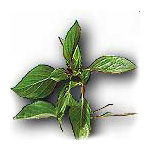
HORAPHA (Sweet Basil)
A sweet basil similar to the kind used in Italian pasta and various European tomato dishes. Used as a vegetable and for flavoring. Horapha is an annual nerbaceous plant, the fresh leaves of which are either eaten raw or used as a flavouring in Thai cooking.
Volatile oil content varies according to different varieties. Therapeutic properties are as carminative, diaphoretic, expectorant, digestant and stomachic agents.
Flavor: mild - sweet
Usage parts: leaves and seeds
Usage in cooking: leaves- in all curries and other spicy dishes seeds- desserts
Volatile oil content varies according to different varieties. Therapeutic properties are as carminative, diaphoretic, expectorant, digestant and stomachic agents.
Flavor: mild - sweet
Usage parts: leaves and seeds
Usage in cooking: leaves- in all curries and other spicy dishes seeds- desserts

KAPHRAO (Holy Basil)
Kraphrao is an annual herbaceous plant that resembles Horapha but has narrower and oftentimes reddish-purple leaves. The fresh leaves, which are used as a flavouring. A sweet basil different from horapa in that the aroma and flavor is released only in cooking. Used in hot and spicy fried dishes.
They contain approximately 0.5% volatile oil, which exhibits antimicrobial activity, specifically as a carminative, diaphoretic, expectorant and stomachic.
Flavor: aromatic, spicy flavor
Usage parts: leaves, seeds
Usage in cooking: leaves - spicy dishes, seeds- medicine
They contain approximately 0.5% volatile oil, which exhibits antimicrobial activity, specifically as a carminative, diaphoretic, expectorant and stomachic.
Flavor: aromatic, spicy flavor
Usage parts: leaves, seeds
Usage in cooking: leaves - spicy dishes, seeds- medicine
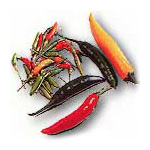
PHRIK (Chilli - Capsicum annuum)
Phrik is an erect, branched, shrub - like herb with fruits used as garnishing and flavouring in Thai dishes. Phrik of several varieties are available in Thailand. As they ripen, they change color from green to red and become hotter. Fully ripe fruits are dried in the sun to give dried chillies, phrik haeng, and these are pounded for ground dried chilli, phrik khi nu, are the hottest type and also the smallest, being only about a centimeter long.
More than 10 types of chilies are used in Thai cooking. They vary in size and color, but all are used for spicy flavoring and decoration. It is the main ingredient of chili paste.
There are many different species. All contain capsaicin, a biologically active ingredient beneficial to the respiratory system, blood pressure and heart. Other therapeutic uses include being a stomachic, carminative and antiflatulence agent, and digestant.
Flavor: spicy hot
Usage parts: pepper pots, fresh leaves
Usage in cooking: All Thai dishes - to add flavor
More than 10 types of chilies are used in Thai cooking. They vary in size and color, but all are used for spicy flavoring and decoration. It is the main ingredient of chili paste.
There are many different species. All contain capsaicin, a biologically active ingredient beneficial to the respiratory system, blood pressure and heart. Other therapeutic uses include being a stomachic, carminative and antiflatulence agent, and digestant.
Flavor: spicy hot
Usage parts: pepper pots, fresh leaves
Usage in cooking: All Thai dishes - to add flavor
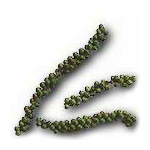
PHRIK THAI (Pepper - Piper nigrum)
Black, white and green peppercorn types. Black is milder and more aromatic than white. Green peppercorns have a special taste all their own. Used in flavoring.
Prik Thai is a branching, perennial climbing plant from whose fruiting spikes both white and black pepper are obtained. Phrik Thai produces berries, which when ripe, are dried and ground with the skins on to give black pepper,or with the skins off to,give white pepper. The most widely available form in Thailand is white pepper.
Fresh pepper is also used in many of Thai dishes.Fresh pepper is green and has a little stronger smell but a little less hot.
Used as a spice and condiment, Prik Thai contains 2 to 4% volatile oil. Therapeutic uses are as carminative, antipyretic, diaphoretic and diuretic agents.
Prik Thai is a branching, perennial climbing plant from whose fruiting spikes both white and black pepper are obtained. Phrik Thai produces berries, which when ripe, are dried and ground with the skins on to give black pepper,or with the skins off to,give white pepper. The most widely available form in Thailand is white pepper.
Fresh pepper is also used in many of Thai dishes.Fresh pepper is green and has a little stronger smell but a little less hot.
Used as a spice and condiment, Prik Thai contains 2 to 4% volatile oil. Therapeutic uses are as carminative, antipyretic, diaphoretic and diuretic agents.
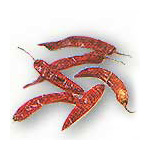
PHRIK HAENG (Dried Chilli)
Phrik Haeng is fully ripened, red spur chillies dried either in the sun or by smoking. They may be large or small, depending on the variety of spur chilli used. They are prepared by removing the seeds, soaking in water, and then pounding in a mortar. Bright red dried chillies should be selected for the color they lend chilli pastes. Smoked chillies are darker in color.
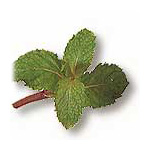
SARANAE (Marsh Mint)
The fresh leaves of this herbaceous plant are used as a flavouring and eaten raw in Thai cuisine.
Volatile oil contents give the plant several therapeutic uses, including carminative,mild antiseptic, local anaestbetic, diaphoretic and digestant properties.
Volatile oil contents give the plant several therapeutic uses, including carminative,mild antiseptic, local anaestbetic, diaphoretic and digestant properties.
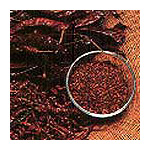
PHRIK PON (Ground Dried Chilli)
There are two types of Phrik Pon : ground spur chilli and ground hot chilli, the former being less hot than the latter. Both are dried and pan roasted before being ground, and are put up for sale in plastic bag. It is best to buy small quantities because, if kept long, the aroma is lost.
Dried chilli is used in spicy chopped meat salads, spicy salads, sour and spicy soups,
and in sauces. It is also a table condiment, used by Thai in the way Westerners use pepper.
Dried chilli is used in spicy chopped meat salads, spicy salads, sour and spicy soups,
and in sauces. It is also a table condiment, used by Thai in the way Westerners use pepper.
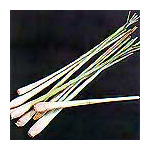
TA-KHRAI (Lemon Grass - Cymbopgon citratus)
This erect annual plant resembles a coarse grey - green grass. Fresh aromatic leaves and bases of the stems are used as a flavouring. This plant looks like coarse grass.
The lower part of the stalk is used for flavoring mainly, but also used as an ingredient in curry paste and certain dishes--the most famous is Tom Yum.
Ta-khrai contains 0.2-0.4 volatile oil. Therapeutic properties are as a diuretic, emmanagogue, antiflatulence, antiflu and antimicrobial agent.
Flavor: lemon like
Usage parts: stalk, leaf
Usage in cooking: curry pastes, hot & sour seafood soup, chicken with galanga soup, and Thai salads
The lower part of the stalk is used for flavoring mainly, but also used as an ingredient in curry paste and certain dishes--the most famous is Tom Yum.
Ta-khrai contains 0.2-0.4 volatile oil. Therapeutic properties are as a diuretic, emmanagogue, antiflatulence, antiflu and antimicrobial agent.
Flavor: lemon like
Usage parts: stalk, leaf
Usage in cooking: curry pastes, hot & sour seafood soup, chicken with galanga soup, and Thai salads
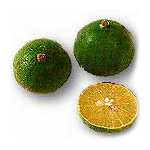
MANAO (Lime)
Manao is used principally as a garnish for fish and meat dishes. The common lime is native to China and Southeast Asia. The lime juice is used in Thai food, mainly for soup and desserts. The peel is used as a flavoring.
The fruit contains Hesperidin and Naringin, scientifically proven antiinflammatory flavonoids. Manao juice is used as an appetiser, and has antitussive, antiflu, stomachic and antiscorbutic properties
The fruit contains Hesperidin and Naringin, scientifically proven antiinflammatory flavonoids. Manao juice is used as an appetiser, and has antitussive, antiflu, stomachic and antiscorbutic properties
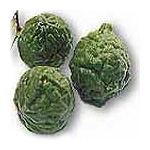
MAKRUT (Kaffir Lime or Bergamot - Citrus hystrix)
A knobby dark green fruit the size of a large lime. Makrut is a green fruit with wrinkled skin. The juice and peel are used in curry paste and cooking as flavoring. Similar to lemon, lemon peel and lemon verbena.
The leaves and peel contain volatile oil. The major therapeutic benefit of the juice is as an appetiser.
Flavor: Sour fruit, lemony aromatic leaf
Usage parts: leave, fruit peel, fruit juice
Usage in cooking: fruit peel- curry paste; leave-hot & sour soup, curry dishes
The leaves and peel contain volatile oil. The major therapeutic benefit of the juice is as an appetiser.
Flavor: Sour fruit, lemony aromatic leaf
Usage parts: leave, fruit peel, fruit juice
Usage in cooking: fruit peel- curry paste; leave-hot & sour soup, curry dishes
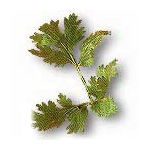
PHAK CHI (Coriander - Coriandrum sativum)
Phak Chi is of the parsley family. The leaves and stems are eaten fresh and used frequently as a garnish. The root (rak phak chi) and the seeds (met phak chi) are ingredients in many dishes. The root is taken from the fresh plant. The seeds which are roughly spherical, 2-4 cm in diameter, a little smaller than pepper, and range color from off-white to brown, have a pleasant taste and fragrance.
Seeds that look like caraway and fennel, but taste quite different. Only cumin is used in Thai cooking. Also used in making curry paste.
They can be bought in the market. It is better to roast and grind seeds immediately before use than to buy ground seed.
Usages: Aromatic, culinary, decorative, and medicinal.
Ripe seeds have a pleasant citrus scent and can be used in potpourris
Seeds that look like caraway and fennel, but taste quite different. Only cumin is used in Thai cooking. Also used in making curry paste.
They can be bought in the market. It is better to roast and grind seeds immediately before use than to buy ground seed.
Usages: Aromatic, culinary, decorative, and medicinal.
Ripe seeds have a pleasant citrus scent and can be used in potpourris
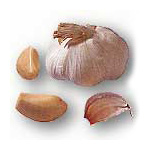
KRATHIAM (Garlic)
Krathiam is an annual herbaceous plant with underground bulbs comprising several cloves. Dried mature bulbs are used as a flavouring and condiment in Thai cuisine. Thai garlic has small cloves covered with a peel that is not tough. Its fragrance is stronger than that of large - clove garlic. In making fried garlic, the peel is usually not removed entirely so that only the flesh remains. Some of the peel is left on the clove, for it is in the peel that the fragrance resides. Krathiam is an ingredient in all types of curries as well as of stir - fried and deep - fried dishes. The fragrance of Krathiam is one hallmark of Thai cooking. Krathiam is also used raw. Thin slices are mixed with chilli and fish sauce and used as a garnish by those who like their food hot.
The bulbs contain 0.1 to 0.36% garlic oil and organic sulfur compounds. Therapeutic uses are as antimicrobial, diaphoretic, diuretic, expectorant, antiflatulence and cholesterol lowering agents.
The bulbs contain 0.1 to 0.36% garlic oil and organic sulfur compounds. Therapeutic uses are as antimicrobial, diaphoretic, diuretic, expectorant, antiflatulence and cholesterol lowering agents.
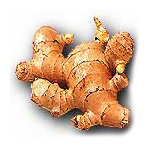
KHING (Ginger)
Khing is an erect plant with thickened, fleshy and aromatic rhizomes. Used in different forms as a food, flavouring and spice.
Its roots are picked for adding to foods and for making drinks. Young ginger is used as a condiment with fowl and beef dishes.
Khing rhizomes contain 1 to 2% volatile oil. Khing's therapeutic uses are as a carminative, antinauseant and antiflatulence agent.
Aromatic leaves and rhizomes
Height: 2-3' tall
Cooking usage: foods and drinks
Its roots are picked for adding to foods and for making drinks. Young ginger is used as a condiment with fowl and beef dishes.
Khing rhizomes contain 1 to 2% volatile oil. Khing's therapeutic uses are as a carminative, antinauseant and antiflatulence agent.
Aromatic leaves and rhizomes
Height: 2-3' tall
Cooking usage: foods and drinks
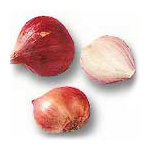
HOM DAENG (Shallot - Allium ascalonicum)
Hom Daeng or zesty small red onions, are annual herbaceous plants which are used as flavouring or seasoning agents. Underground bulbs comprise garlic-like cloves.
Hom Daeng bulbs contain volatile oil. Therapeutic properties include the alleviation of stomach discomfort, and as antithelmintic, antidiarroheal, expectorant, antitussive, diuretic and antiflu agents.
Hom Daeng bulbs contain volatile oil. Therapeutic properties include the alleviation of stomach discomfort, and as antithelmintic, antidiarroheal, expectorant, antitussive, diuretic and antiflu agents.
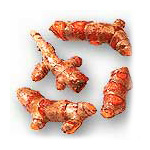
KHAMIN (Turmeric - Curcuma longa)
Khamin is a small member of the ginger family with brown rhisomes, and provides yellow colouring for Thai food. Bright orange roots which are used for the coloring in yellow curries. White turmeric is used as a raw vegetable and resembles ginger.
The rhizomes contain 3 to 4% volatile oil with unique aromatic characteristics. Turmeric's therapeutic properties manifest as a carminative, antiflatulence and stomachic.
The rhizomes contain 3 to 4% volatile oil with unique aromatic characteristics. Turmeric's therapeutic properties manifest as a carminative, antiflatulence and stomachic.
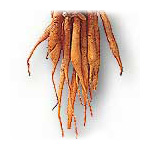
KRACHAI (no English name - Kaempferia panduratum)
This erect annual plant with aromatic rhizomes and yellow-brown roots, is used as a flavouring. The rhizomes contain approcimately 0.8% volatile oil. The plant has stomachache relieving and antimicrobial properties, and therapeutic benefits as an antitussive and antiflatulence agent. Krachai sometimes known as aromatic ginger and grows bunches of slender and short yellow-brown tuberous roots and is used in fish dishes. Peeled tubers may be eaten with a dip.
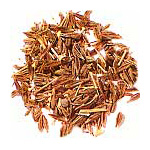
YIRA (Cumin - Cuminium cyminu)
Yira is a small shrubbery herb which has elongated yellow-brown seeds about 5 mm in length, which are ridged longitudinally and often have a seed stalk attached. They are roasted before use to heighten their fragrance.
Its fruit of which contains 2 to 4% volatile oil with a pungent odour, and which is used as a flavouring and condiment. Yira's therapeutic properties manifest as a stomachic, bitter tonic, carminative, stimulant and astringent.
Its fruit of which contains 2 to 4% volatile oil with a pungent odour, and which is used as a flavouring and condiment. Yira's therapeutic properties manifest as a stomachic, bitter tonic, carminative, stimulant and astringent.
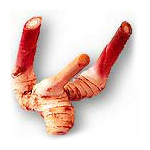
KHA (Galanga - Alpinia galangal)
Kha is an erect annual plant with aromatic, ginger-like rhizomes, and commonly used in Thai cooking as a flavouring.
These roots are larger than the common ginger, and galanga is always used to make curry pastes used in Thai food and in Tom Yum.
The approximately 0.04 volatile oil content has therapeutic uses as carminative, stomachic, antirheumatic and antimicrobial agents. Kha is a larger and lighter - colored relative of ginger and has its own distinctive taste.
These roots are larger than the common ginger, and galanga is always used to make curry pastes used in Thai food and in Tom Yum.
The approximately 0.04 volatile oil content has therapeutic uses as carminative, stomachic, antirheumatic and antimicrobial agents. Kha is a larger and lighter - colored relative of ginger and has its own distinctive taste.




